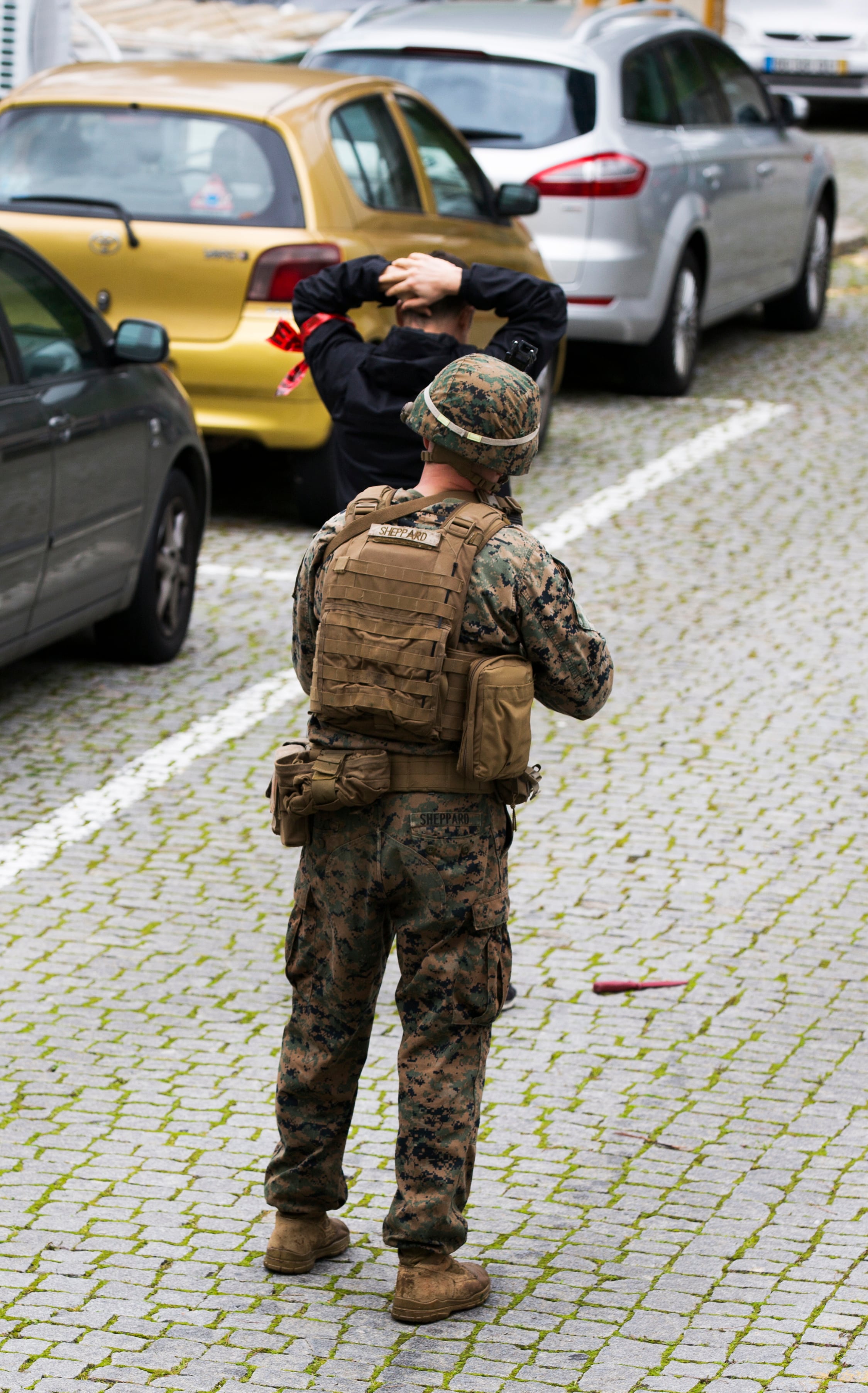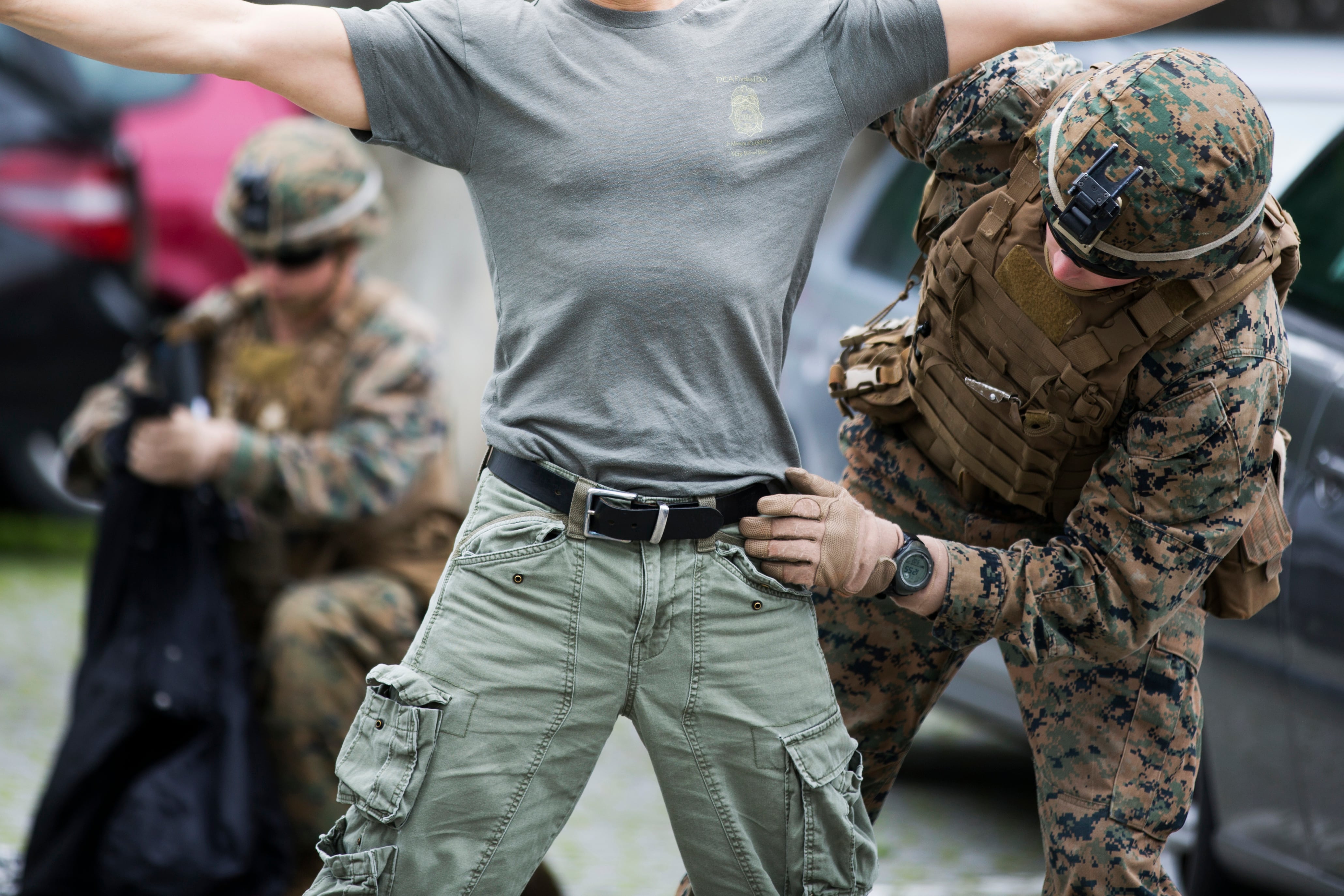U.S. Marines in Europe are training to descend on an embassies y overrun by terrorists, dealing with active shooters or violent rioters as concerns about safety at diplomatic facilities mount following sophisticated attacks on that continent complex more attacks and then evacuate personnel to a secure command post. In early February, Marines with Special Purpose Air-Ground Task Force - Crisis Response - Africa descended on the U.S. Embassy in Lisbon, Portugal to deal with active shooters, violent rioters, complex attacks and then evacuate personnel to a secure command post.
Members of the Marine Corps' Spain-based crisis response unit recently spent three days at the U.S. Embassy in Lisbon, Portugal, responding to mock emergencies. The exercises prepared the Marines for real-world missions since their unit could be tapped to rapidly reinforce security at State Department posts across Africa or Europe.
Gaining this kind of practical experience in as realistic training as possible was enormous beneficial, said 1st Lt. John McCombs, a SP-MAGTF-CR-AF spokesman.
"The ability to do these kinds of missions in an actual embassy is only going to help us further down the line if and when we have to ... respond to a real-world situation in which we have to go and reinforce [one]an embassy," said 1st Lt. John McCombs, a spokesman for the crisis response force.

Pvt. Tristan Sheppard, an automatic rifleman with 1st Battalion, 8th Marines, give commands to a role player acting as a suspect during an active shooter exercise at the U.S. Embassy in Portugal.
Photo Credit: Sgt. Kassie McDole/Marine Corps
Responding to emergencies at embassies is one of the crisis response force's main missions. The Marine Corps created the land-based unit about seven months after the 2012 terror attack It’s not just hypothetical, however.SP-MAGTF-CR-AF stood up in 2013 in the wake of the terrorist attack on a U.S. consulate in Benghazi, Libya, that left four Americans dead.
Within months of the Marines deploying to Spain, the unit was tasked with evacuating State Department personnel from the embassy in South Sudan amid fears that a civil war was about to break out. In July 2014, the task force helped move embassy personnel from Libya to Tunisia when violent clashes between militias broke out in Tripoli.
Embassy reinforcement missions require close interaction with State Department personnel. During the mock attacks at the embassy in Portugal, the crisis response force worked alongside the Marine security guards regularly based there, as well as State Department officials and Portuguese security forces. The Marines conducted the realistic training alongside the embassies' Marine security guards, State Department personnel The scenarios -all notional - were part of a three-day training exercise which honed their ability to work with embassy Marines, State Department personnel and host nation security forces when called on to rapidly reinforce America’s embassies across the African continent in the face of unfolding crises.
That allowed e training gave the Marines an opportunity to troubleshoot how they would integrate with those forces already on the scene ground, said 1st Lt. Nicholas Berger, a platoon commander with the crisis response force.
"Moving out to Lisbon allowed us to work through what an embassy reinforcement would actually be like for our company," said 1st Lt. Nicholas Berger, a platoon commander with the crisis response force. "Our role was to provide security external to the embassy, allowing them to change focus to the inside of the compound."

Pvt. Tristan Sheppard, an automatic rifleman with 1st Battalion, 8th Marines, searches a suspect during a training exercise that simulated an attack on an embassy.
Photo Credit: Sgt. Kassie McDole/Marine Corps
Once on the ground, the Marines worked with trainers from the State Department’s diplomatic security service to refine their skills through the scenarios. In one scenario simulating a riot, with volunteers from the embassy acting as role-players acting as a gathering mob got increasingly violent, increased in pitch and intensity, even throwing a Molotov cocktail to test how the Marines responded would deal with the situation.
The exercise challenged the Marines to communicate quickly and effectively with diplomatic security staff in the midst of a crisis, Berger said. Working out the nuts and bolts of integration at the tactical, ground level was the whole point of February’s exercise, Berger said.
"The hardest part was finding ... how to communicate effectively both with the squad leaders and the DSS workers exactly what my platoon was doing, what they needed from us and how we could help," he said. "It was really putting myself in the right place, putting my platoon sergeant in the right place [and] talking to the right people and then allowing my squads to operate off of intent."
The scenarios also challenged infantry Marines to use the right tactics respond tactically in an embassy setting with limited information about the attack, said constantly can't see the big picture, infantry squad leader Cpl. Zeith Horr, an infantry squad leader.
"We had to be able to take the things that we normally do in a regular or non-permissive environment and shape that to an embassy environment where you had American citizens, local nationals and a whole range of people," he said. "You had to figure out where you fit in and also apply your skills in a different manner than you might be used to."
Gaining this kind of practical experience in as realistic training as possible was enormous beneficial, said 1st Lt. John McCombs, a SP-MAGTF-CR-AF spokesman.
"The ability to do these kinds of missions in an actual embassy is only going to help us further down the line if and when we have to respond to a real-world situation in which we have to go and reinforce an embassy," he said. including Ambassador J. Christopher Stevens.On July 26, 2014, SP-MAGTF-CR-AF Marines were called on to evacuate U.S. embassy personnel from Tripoli, Libya, as fighting between rival militias flared up and threatened to engulf their compound.In 2014, the Marines The 24-hour mission was a success, but underscored the difficulty of coordinating with the State Department when the U.S. Ambassador to Libya, Deborah Jones, scrapped the Marine’s planned air extraction in favor of taking a ground convoy to neighboring Tunisia.
Working out the nuts and bolts of integration at the tactical, ground level was the whole point of February's exercise, Berger said.
"The hardest part was finding how to communicate effectively both with the squad leaders and the DSS workers exactly what my platoon was doing, what they needed from us and how we could help," he said. "It was really putting myself in the right place, putting my platoon sergeant in the right place, talking to the right people and then allowing my squads to operate off of intent."
The exercise also put the Marines' tactics, techniques and procedures to the test.
They scenarios challenged them to figure out how to best apply what they knew to an embassy setting where, from a tactical standpoint, they constantly can't see the big picture, infantry squad leader Cpl. Zeith Horr said.
"We had to be able to take the things that we normally do in a regular or non-permissive environment and shape that to an embassy environment where you had American citizens, local nationals and a whole range of people," he said. "You had to figure out where you fit in and also apply your skills in a different manner than you might be used to."
In addition to providing a quick reaction force able to reinforce or evacuate embassies, the task force remains at the ready to recover downed aircraft and personnel, humanitarian assistance and disaster relief as well as routinely trains military throughout the African continent.
Matthew L. Schehl covers training and education, recruiting, West Coast Marines, MARSOC, and operations in Europe, Africa and the Middle East for Marine Corps Times. He can be reached at mschehl@marinecorpstimes.com.




